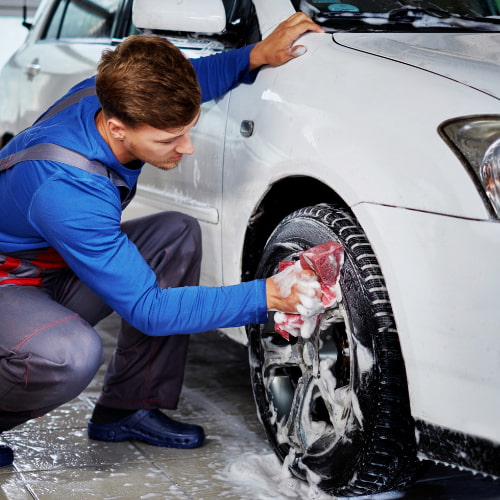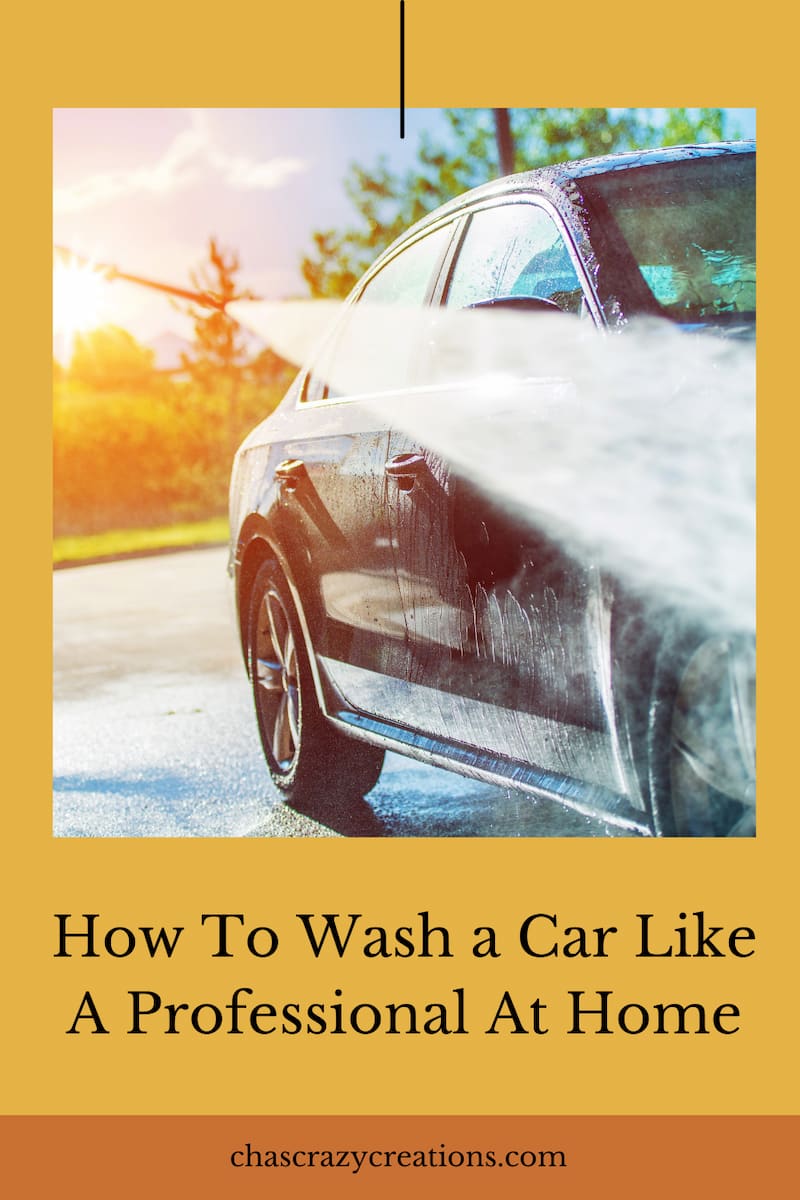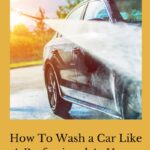How To Wash a Car Like A Professional At Home
Are you wondering how to wash a car like a professional? Here are a few tips and tricks to get you started today.
This post may contain affiliate links, I earn from qualifying purchases at no extra cost to you. Click here for my disclosure policy
Car cleaning is a task that we associate with some difficulties. It is convenient to carry out periodic cleaning so that our car looks good both outside and inside. But do you know the tricks of the professionals? In this article, we will give you nine recommendations so that you can leave your car looking as if it was washed at a professional car wash.

What is the proper way to wash your car?
Table of Contents
- 1 What is the proper way to wash your car?
- 1.1 1. Let’s start from the inside
- 1.2 2. Don’t forget about the air ducts
- 1.3 3. Use a low acid wheel cleaner
- 1.4 4. Use a sponge
- 1.5 5. Remember that the paint also needs to be cleaned
- 1.6 6. Do I need polishing?
- 1.7 7. Protect the paint with wax
- 1.8 8. It’s the turn of glasses and mirrors
- 1.9 9. Use wax at every change of season
- 2 Further Reading
- 3 How To Wash a Car Q & A
1. Let’s start from the inside
Your car needs care both inside and out. The dashboard, carpets, or seats deserve the same attention as the exterior paint, hood, wheels, or tires. Do not finish washing the car ahead of time because the water dispenser has run out of coins. If you start from the inside, you won’t forget to do the cleaning that is crucial: cleaning the interior.
The first thing to clean is the gaps, the mats, and the floor. You may have noticed how neat and pleasant the interior of any rented car looks when it is clean. The more you can use an air compressor to blow the ingrained dirt out of the carpets, the better. If you don’t have one, you can use a powerful vacuum cleaner and a hard brush to shake off the dirt.

2. Don’t forget about the air ducts
Compressed air from a small portable compressor is an easy way to blow dust and dirt out of heating and air conditioning ducts. The trick is to target the vents where dust and dirt accumulate, causing a musty smell. If your car has an air filter, you can replace it from time to time or remove it and blow out dust and dirt.
3. Use a low acid wheel cleaner
Before you start cleaning the body, first of all, take care of the wheels and tires. In the latter case, we can use one of the many products on the market, but the less acid in it, the better, since acidity can lead to a loss of shine or color of tires.

4. Use a sponge
The best tool for cleaning the body is a sponge. If you wash them with dish soap or dishwashing detergent, as most people do, the wax coating will be stripped. A car shampoo is a better option for cleaning your vehicle. Prepare a good bucket of soap and water and get to work!
After you have cleaned the exterior of the car, rinse it with plenty of water and dry the surface with a towel or microfiber cloth, which does not scratch the paint and has great absorbency. This way, you will avoid the appearance of stains that form when water evaporates and are caused by traces of dirt.
5. Remember that the paint also needs to be cleaned
It often takes more than a simple wash to clean the paint. Technogenic pollution settles on the paint and after a while, can penetrate into the color layer. While the car is in the shade, run your hand over the painted surface. If you notice that it is rough, then it needs to be cleaned. In more extreme cases, you can use paint cleaners — liquids that remove wax and also clean the top layer of paint, removing unwanted chemicals from the environment that have stuck to the paint.
6. Do I need polishing?
By polishing the body, you will smooth the surface of the paint. It will shine, and your car will look like new. Some polishes contain wax, which also protects the paint, but the wax itself does not soften the paint. A vibrating grinding machine can be used to polish the paint. Professionals use a rotary grinder, which works faster, but if care is not taken, it can damage the paintwork.
7. Protect the paint with wax
When the car left the factory, it looked shiny. Over time, the paint deteriorates due to weather conditions. Therefore, we need to polish the body with wax. Professionals usually use two layers of wax. The purpose of the second layer is to cover areas that have not been completely impregnated with the first layer.

8. It’s the turn of glasses and mirrors
The windows and mirrors of the car are the last elements that we will clean. We can use a good glass cleaner (it is better if it does not contain ammonia) and, after wiping it with a sponge, make sure that we have removed the entire product with a rag. To make it cleaner, you can dry the surface with a newspaper.
9. Use wax at every change of season
Spots and scratches may appear between cleanings. Especially if your car spends nights and days outdoors. In these cases, it is recommended to clean the car at any time of the year, applying wax to the body to protect it as much as possible.
If you don’t want to take care of car washing so much, then you can consider using a car rental service like Dubai Renty.ae. The rental car for the trip will be delivered to you in the best possible way. There is even a Lamborghini Urus available for rent in Dubai, so you can take it for the duration of your trip.
Shop any of these stores and I receive a small commission at no cost to you.
 Ontel Carwash Cannon Foam B...Shop on Amazon
Ontel Carwash Cannon Foam B...Shop on Amazon Meguiar's Gold Class Car Wa...Shop on Amazon
Meguiar's Gold Class Car Wa...Shop on Amazon Armor All Car Wash Kit, Inc...Shop on Amazon
Armor All Car Wash Kit, Inc...Shop on Amazon Armor All Car Interior Clea...Shop on Amazon
Armor All Car Interior Clea...Shop on Amazon Black Magic BM41023 No No S...Shop on Amazon
Black Magic BM41023 No No S...Shop on Amazon

Further Reading
How To Wash a Car Q & A
Washing your car is an essential part of car maintenance to keep your car’s finish looking its best. Whether you’re a novice or an experienced car enthusiast, a step-by-step approach will help you achieve a clean, spotless vehicle.
To begin, gather your car washing kit, which should include a bucket, wheel brush, tar remover, soapy water, and a rinse bucket. It’s important to wash your car in a shady spot or on a cloudy day to avoid direct sunlight, which can cause the soapy water to dry too quickly, leaving unsightly suds on your car’s surface.
Start by rinsing the car’s exterior with plain water to remove loose dirt and debris. Pay close attention to the nooks and crannies, such as crevices, cracks, and jambs, where dirt can easily accumulate. Birds droppings, bugs, and salt are common culprits, and a thorough rinse can help dislodge these stubborn stains.
Next, fill one of your washing buckets with soapy water. Add a quality car wash soap, like Meguiar’s, to create a rich lather of suds. Begin by scrubbing the top of the car with a soft microfiber mitt or sponge, working your way down. The key is to use a gentle touch to avoid damaging the car’s finish. Make sure to pay special attention to the headlights and other delicate areas.
For the wheels and tires, use a wheel brush and soapy water to remove brake dust, dirt, and road grime. The wheel brush can reach into the crevices and traps dirt that plain water might not remove. Also, don’t forget to clean the floor mats by scrubbing them thoroughly and rinsing them with plain water.
As you continue to scrub the car’s surface, use a second bucket for rinsing your mitt or sponge to avoid contaminating the soapy water with dirt. This helps prevent swirl marks and scratches on your car’s finish.
For any stubborn spots like tar or bird droppings, you can use a specialized tar remover. Apply it carefully, and allow it to sit for a moment before gently scrubbing and rinsing. These products are great for targeting specific stains without damaging your car’s finish.
After you’ve thoroughly scrubbed all parts of the car, it’s time for the final rinse. Use your rinse bucket filled with plain water to wash away the soapy residue. Make sure you rinse the car from top to bottom to avoid leaving streaks, and pay extra attention to crevices and cracks, where soap can hide.
To complete the process, open the car’s trunk and doors to clean the jambs and crevices that may have been overlooked. A good rinse will ensure that all soap is gone, and your car is left spotless and gleaming.
Now, with your car wet and clean, you can feel proud of your work and admire the shiny result. Washing your car not only enhances its appearance but also helps preserve its value. So, the next time you find yourself with a bit of free time and your car in need of a scrub, consider washing it in the comfort of your own driveway, following these step-by-step instructions for a sparkling finish.
In this fast-paced world, we often struggle to find the balance between maintaining cleanliness and conserving resources. While it ultimately depends on individual circumstances, washing your car once a week strikes a reasonable middle ground for most people. By doing so, you can keep your vehicle looking its best without excessive water usage or too much of your valuable time. Remember, a clean car not only enhances its appearance but also protects the paint and preserves its value in the long run. So, aim for a weekly wash to strike that perfect balance and keep your wheels shining!
When it comes to washing your car, protecting the paint is of utmost importance. To maintain the integrity of your vehicle’s paint job, opt for a pH-neutral car wash soap specifically designed for automotive use. This type of soap helps to remove dirt and grime effectively without stripping the protective wax or sealants on your car’s surface. Additionally, consider investing in a microfiber wash mitt or sponge, as they are gentle on the paint and help prevent any potential scratches. Remember to rinse your mitt or sponge frequently and avoid using abrasive materials, such as brushes or harsh chemicals, as they can damage the paint. By using the right tools and products, you can keep your car clean and pristine without compromising its beautiful finish.
While washing up liquid may seem like a convenient option, it is generally not recommended for washing cars. Washing up liquid is formulated for removing grease and grime from dishes, not for automotive surfaces. Using it on your car can strip away the protective wax, leaving the paint susceptible to damage from UV rays, contaminants, and even scratches. Furthermore, the higher pH levels in washing up liquid can disrupt the paint’s pH balance, potentially leading to fading or discoloration over time. To ensure the longevity and appearance of your car’s paint, it’s best to stick to pH-neutral car wash soaps that are specifically designed for automotive use.
Washing your car with a pressure washer can be efficient and effective if done correctly and safely. Here are some guidelines to follow:
1. Use the right nozzle: Start by using a nozzle with a wide spray angle, such as 40 degrees, to avoid causing damage to the paint or clear coat. Position the nozzle at a safe distance from the car, around 2-3 feet.
2. Pre-rinse the car: Before applying any soap, use the pressure washer to pre-rinse the car, removing loose debris and dirt. Start from the top and work your way down, allowing the water to flow gently over the surface.
3. Choose a gentle detergent: Opt for a car-specific, pH-neutral detergent to protect the paint. Avoid using harsh chemicals or household cleaners that may damage the finish.
4. Apply the soap: Using a suitable foam cannon or attachment, evenly apply the soap to the car’s surface. Allow it to dwell for a few minutes, loosening any dirt or grime.
5. Rinse thoroughly: Switch back to the wide spray angle nozzle and rinse the car thoroughly, starting from the top and working your way down. Ensure all soap residue is completely removed.
6. Mind the pressure: Never use a pressure washer at high pressure directly on sensitive areas such as windows, trims, or mirrors. Use lower pressure or even switch to a garden hose for such areas.
7. Dry the car: To prevent watermarks, use a clean microfiber towel or chamois to gently dry the car’s surface. Begin by blotting rather than rubbing to avoid potential scratches.
By following these steps, you can safely and effectively clean your car using a pressure washer, giving it that fresh and sparkling look without causing any harm.
To wash your car effectively, here’s a list of materials and products you’ll need:
1. Car wash soap: Choose a pH-neutral car wash soap designed for automotive use. Avoid using harsh household cleaners or washing up liquid.
2. Two buckets: Fill one bucket with clean water for rinsing your wash mitt or sponge, and another bucket with the soapy solution for washing the car. This helps prevent dirt and debris from contaminating your cleaning tools.
3. Wash mitt or sponge: Use a high-quality, microfiber wash mitt or sponge to safely wash your car. These materials are gentle on the paint and help prevent scratches.
4. Wheel cleaner: Opt for a dedicated wheel cleaner to effectively remove brake dust and grime from your wheels. Make sure it is safe for use on your specific wheel type (e.g., alloy, chrome, etc.).
5. Soft-bristle brush: Use a soft-bristle brush to clean the tires and wheel wells. This helps reach tight spots and remove stubborn dirt.
6. Microfiber towels or chamois: Have a few clean, lint-free microfiber towels or a chamois available for drying your car after washing. These materials absorb water effectively without scratching the surface.
7. Water hose or pressure washer: Use a water hose with an adjustable nozzle or a pressure washer for rinsing the car. Adjust the water pressure to a safe and gentle level.
8. Optional: Clay bar or paint cleaner: If your car’s paint has embedded contaminants or feels rough, a clay bar or paint cleaner can help remove them, leaving a smooth finish. Follow the instructions carefully.
Having these essential materials and products at hand will allow you to wash your car thoroughly and ensure its appearance remains pristine and protected.










